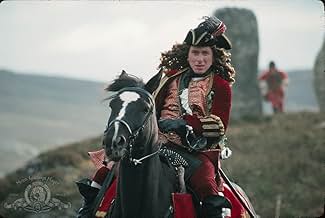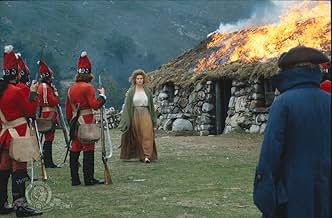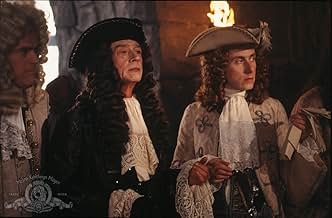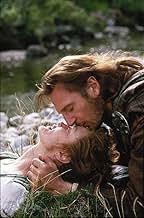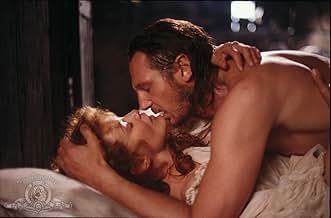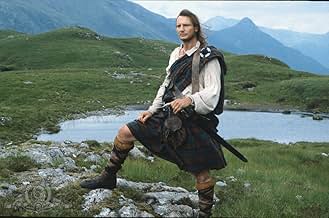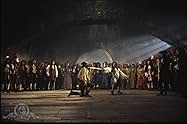CALIFICACIÓN DE IMDb
6.9/10
48 k
TU CALIFICACIÓN
En 1713 en Escocia, Rob Roy MacGregor es traicionado por un noble y su sobrino y se convierte en proscrito, acusado de ser un Jacobita, en busca de venganza.En 1713 en Escocia, Rob Roy MacGregor es traicionado por un noble y su sobrino y se convierte en proscrito, acusado de ser un Jacobita, en busca de venganza.En 1713 en Escocia, Rob Roy MacGregor es traicionado por un noble y su sobrino y se convierte en proscrito, acusado de ser un Jacobita, en busca de venganza.
- Dirección
- Guionista
- Elenco
- Nominado a 1 premio Óscar
- 2 premios ganados y 5 nominaciones en total
David Brooks Palmer
- Duncan
- (as David Palmer)
- Dirección
- Guionista
- Todo el elenco y el equipo
- Producción, taquilla y más en IMDbPro
Opiniones destacadas
"Rob Roy" came out in 1995 with a couple other heroic swordplay films: "Braveheart" and "First Knight." I prefer "Rob Roy" to "Braveheart," even though the two films shouldn't really be compared since "Rob Roy" focuses on the conflict of individuals in Old Scotland and "Braveheart" focuses more on whole armies battling.
The location cinematography of the Scottish Highlands is breathtaking (and superior to "Braveheart"). Liam Neeson and Jessica Lange are fine in the roles of Rob Roy and his wife. The sword-fighting (between individuals) ranks with the best in cinematic history. The film also possesses a very realistic vibe -- no anachronisms or campy humor here; the pic really helps one realize what life was like in rural Scotland 300 years ago.
What works best, to my mind, is Tim Roth's exceptional performance as Rob Roy's foppish-but-deadly nemesis. This is a villain you love to loathe. The Roth character is so foppish that he appears somewhat effeminate; but this is merely disguise as he's actually a ruthless master swordsman. Surely this is one of film's top villains ever (It doesn't sound right to say "good villain," does it?).
On the downside, the story doesn't have a lot of drive from beginning to end unlike, say, "Last of the Mohicans." Your attention may wander at points. Of course this may not be an entirely bad thing in light of the schizophrenic editing of many films post-"Armageddon" (1998). In other words, the leisurely pace can be refreshing.
There are aspects not appropriate for children: Sexual brutality (a rape scene) and vulgarity (a man shoves his fingers up a woman's nightgown); as well as blatant love-making. There are also overt scenes of, believe it or not, urination; many may regard this as needless, but (for me) it helped drive home the point of what everyday life was like back then, e.g. Where do you pee if you're living in a shack out in the hills? Or, in the middle of the night, if there's no upstairs bathroom?
The story's lack of drive prevents "Rob Roy" from attaining true greatness in my mind, but the positive aspects noted above certainly achieve greatness and there are several memorable scenes.
The film runs 2 hours, 19 minutes, and was shot entirely in Scotland.
GRADE: B+
The location cinematography of the Scottish Highlands is breathtaking (and superior to "Braveheart"). Liam Neeson and Jessica Lange are fine in the roles of Rob Roy and his wife. The sword-fighting (between individuals) ranks with the best in cinematic history. The film also possesses a very realistic vibe -- no anachronisms or campy humor here; the pic really helps one realize what life was like in rural Scotland 300 years ago.
What works best, to my mind, is Tim Roth's exceptional performance as Rob Roy's foppish-but-deadly nemesis. This is a villain you love to loathe. The Roth character is so foppish that he appears somewhat effeminate; but this is merely disguise as he's actually a ruthless master swordsman. Surely this is one of film's top villains ever (It doesn't sound right to say "good villain," does it?).
On the downside, the story doesn't have a lot of drive from beginning to end unlike, say, "Last of the Mohicans." Your attention may wander at points. Of course this may not be an entirely bad thing in light of the schizophrenic editing of many films post-"Armageddon" (1998). In other words, the leisurely pace can be refreshing.
There are aspects not appropriate for children: Sexual brutality (a rape scene) and vulgarity (a man shoves his fingers up a woman's nightgown); as well as blatant love-making. There are also overt scenes of, believe it or not, urination; many may regard this as needless, but (for me) it helped drive home the point of what everyday life was like back then, e.g. Where do you pee if you're living in a shack out in the hills? Or, in the middle of the night, if there's no upstairs bathroom?
The story's lack of drive prevents "Rob Roy" from attaining true greatness in my mind, but the positive aspects noted above certainly achieve greatness and there are several memorable scenes.
The film runs 2 hours, 19 minutes, and was shot entirely in Scotland.
GRADE: B+
Overshadowed by "Braveheart" released the same year, the two costume dramas beg comparison. I admit my bias against Mel Gibson, yet I maintain a rational preference for "Rob Roy." Both "Braveheart" and "Rob Roy" compellingly depict Scots history in bloody, romantic fashion. "Braveheart" is an epic paean to individual honor and courage and a fine revenge fantasy. It's also melodramatic, anachronistic and maudlin. Note its cornball usage of slow motion filming. Its violence is both ugly and glorious. It is the latter quality which makes it more appealing to the adolescent mindset. While "Braveheart" surpasses "Rob Roy" in sheer levels of carnage (not to mention its indulgent running time), the latter film is ultimately more mature and satisfying. Its action is more understated, yet more surprising and clever. Its sex is less showy, yet more erotic. "Rob Roy" also has a better realized romantic interest. Its dialog attempts to approximate the poetry of the period. Its rotted teeth in the mouths of the actors attempt to approximate the dentistry of the era. And Tim Roth is a superlative villain. Also recommended: "The Last of the Mohicans" and "The Patriot." You may find the latter more akin to "Braveheart" with its emphasis on blood lust, with the former more similar to "Rob Roy" in tone. All the of the aforementioned movies merit their R ratings for violence.
Well done, scenic, finely made film, Liam Neeson is great here and shoulda had the same basic part in Phantom Menace, he is a force of nature here. Roth is a great nasty, Hurt too. I thought the assault scene on Jessica was tough to watch but that crap did happen. The British were tyrants up in the High Heather in the 1700s even as they were in the 1300s in 'Bravehearts' day.
I see this as a bit of a forerunner to Braveheart, though they came out at about the same time, it shoulda done better at the box office and ditto at the Oscars.
***1/2, and boys...that final fight between Roth and Liam...my o my.
I see this as a bit of a forerunner to Braveheart, though they came out at about the same time, it shoulda done better at the box office and ditto at the Oscars.
***1/2, and boys...that final fight between Roth and Liam...my o my.
"Rob Roy" was made at a time when the success of "Dances with Wolves" and "Unforgiven" had revived interest in the traditional Western, and director Michael Caton-Jones, himself a Scot, has admitted that the film is essentially a disguised Western. It transfers what could be a classic Western plot from 19thcentury America to early 18th century Scotland, with claymores standing in for six-shooters. The hero is even a cattle drover or, as Americans would put it, a cowboy. That hero, Robert Roy MacGregor, was a real historical figure who also features in Walter Scott's novel of the same name. ("Roy" in this context was a nickname, derived from Gaelic, meaning "red-haired", but here it is treated as a second Christian name; Liam Neeson does not play the part in a red wig).
The film does not follow Scott's plot but is loosely based on the facts of the real MacGregor's life. In 1713 Rob Roy, a clan chief in the Scottish Highlands, is financially ruined by the machinations of the unscrupulous Marquess of Montrose and his villainous protégé Archibald Cunningham. (Cunningham is fictitious but Montrose was another real person). Cunningham has been described as an "aristocrat", but this is not really accurate because, for all his dandyish appearance and foppish mannerisms, he is really the illegitimate son of a prostitute and does not know who his real father is. Montrose has probably taken him under his wing because he recognises in him a kindred spirit, equally unscrupulous and even more ruthless.
When Rob Roy is unable to repay the money he owes, Montrose has him declared an outlaw, seizes his land and slaughters his cattle; Cunningham brutally rapes his wife Mary. Rob Roy and his followers, who have fled into hiding in the mountains, wage a guerrilla campaign of revenge against Montrose, stealing his cattle and other property.
This was one of two historical films with a Scottish setting made in 1995, the other being the Oscar-winning "Braveheart". The two films share one feature, namely a somewhat disapproving attitude towards homosexuality, which today makes them look rather old-fashioned, even though they were only made around twenty years ago. In "Braveheart" the future King Edward II is portrayed as stereotypically weak and effeminate, whereas here the treacherous Cunningham is gratuitously made bisexual, a lover of boys as well as women, a piece of characterisation which the scriptwriter presumably thought would make him seem all the nastier.
That said, I must say that I found "Rob Roy" a considerably better film than the much-hyped "Braveheart". Mel Gibson's epic is a reasonably entertaining adventure story, but it does have its faults, quite apart from its many historical inaccuracies. It is overlong by at least half an hour, and the acting is of a variable standard. In "Rob Roy" Caton-Jones paces the action in a more satisfactory way than does Gibson, and the acting is also a lot better. I was not too keen on Tim Roth's performance, as I felt that he made Cunningham a bit too much of a one-dimensional pantomime villain, but there are three outstanding contributions from Neeson, Jessica Lange and John Hurt.
Despite his status as Chief of Clan MacGregor, Rob Roy lives simply in a modest house which contrasts sharply with Montrose's elaborate palace. The code by which he lives is equally simple- honesty, loyalty and honour; when Montrose offers to forgive Rob's debt if Rob will testify falsely against one of Montrose's enemies, Rob indignantly refuses. Hurt's Montrose appears to be an elegant, courtly gentleman, but his surface sophistication hides a ruthless opportunist who will use other people in any way he can, provided it is to his advantage. Mary MacGregor could simply have come across as a hapless victim and little else, but Lange (who copes well with the Scottish accent) instead plays her as a tough, independent-minded woman who frequently disagrees with her husband even though she loves him dearly.
The sword-fighting scenes, particularly the climactic duel between Rob Roy and Cunningham, were well handled; the film-makers clearly realised that the Scottish claymore was a heavier weapon than the duelling rapiers more commonly seen on screen and called for a different fighting style. Overall this is a splendid, stirring historical yarn on the themes of honour, love and loyalty. 8/10
The film does not follow Scott's plot but is loosely based on the facts of the real MacGregor's life. In 1713 Rob Roy, a clan chief in the Scottish Highlands, is financially ruined by the machinations of the unscrupulous Marquess of Montrose and his villainous protégé Archibald Cunningham. (Cunningham is fictitious but Montrose was another real person). Cunningham has been described as an "aristocrat", but this is not really accurate because, for all his dandyish appearance and foppish mannerisms, he is really the illegitimate son of a prostitute and does not know who his real father is. Montrose has probably taken him under his wing because he recognises in him a kindred spirit, equally unscrupulous and even more ruthless.
When Rob Roy is unable to repay the money he owes, Montrose has him declared an outlaw, seizes his land and slaughters his cattle; Cunningham brutally rapes his wife Mary. Rob Roy and his followers, who have fled into hiding in the mountains, wage a guerrilla campaign of revenge against Montrose, stealing his cattle and other property.
This was one of two historical films with a Scottish setting made in 1995, the other being the Oscar-winning "Braveheart". The two films share one feature, namely a somewhat disapproving attitude towards homosexuality, which today makes them look rather old-fashioned, even though they were only made around twenty years ago. In "Braveheart" the future King Edward II is portrayed as stereotypically weak and effeminate, whereas here the treacherous Cunningham is gratuitously made bisexual, a lover of boys as well as women, a piece of characterisation which the scriptwriter presumably thought would make him seem all the nastier.
That said, I must say that I found "Rob Roy" a considerably better film than the much-hyped "Braveheart". Mel Gibson's epic is a reasonably entertaining adventure story, but it does have its faults, quite apart from its many historical inaccuracies. It is overlong by at least half an hour, and the acting is of a variable standard. In "Rob Roy" Caton-Jones paces the action in a more satisfactory way than does Gibson, and the acting is also a lot better. I was not too keen on Tim Roth's performance, as I felt that he made Cunningham a bit too much of a one-dimensional pantomime villain, but there are three outstanding contributions from Neeson, Jessica Lange and John Hurt.
Despite his status as Chief of Clan MacGregor, Rob Roy lives simply in a modest house which contrasts sharply with Montrose's elaborate palace. The code by which he lives is equally simple- honesty, loyalty and honour; when Montrose offers to forgive Rob's debt if Rob will testify falsely against one of Montrose's enemies, Rob indignantly refuses. Hurt's Montrose appears to be an elegant, courtly gentleman, but his surface sophistication hides a ruthless opportunist who will use other people in any way he can, provided it is to his advantage. Mary MacGregor could simply have come across as a hapless victim and little else, but Lange (who copes well with the Scottish accent) instead plays her as a tough, independent-minded woman who frequently disagrees with her husband even though she loves him dearly.
The sword-fighting scenes, particularly the climactic duel between Rob Roy and Cunningham, were well handled; the film-makers clearly realised that the Scottish claymore was a heavier weapon than the duelling rapiers more commonly seen on screen and called for a different fighting style. Overall this is a splendid, stirring historical yarn on the themes of honour, love and loyalty. 8/10
Rob Roy is directed by Michael Caton-Jones and written by Alan Sharp. It stars Liam Neeson, Jessica Lange, John Hurt, Tim Roth, Eric Stoltz, Andrew Keir and Brian Cox. Music is by Carter Burwell and cinematography by Karl Walter Lindenlaub.
Neeson is Rob Roy MacGregor, an 18th Century Scottish historical figure who borrows £1,000 from the Marquis of Montrose (Hurt) with the plan to improve his clan's way of life. But the money is stolen in transit by the dastardly Archibald Cunnigham (Roth), so unable to repay the loan, Roy is forced to live as an outlaw. From such seeds are legends born.
Beautifully shot on location in parts of the Scottish Highlands, Rob Roy somewhat got lost in the slip stream of Mel Gibson's Braveheart. A shame, for although not as epic or as rousing as Gibson's Oscar grabber, Caton-Jones' film is a different and more reflective type of historical piece. Thematically the film is a play on virtues, in fact it's a trumpet playing fanfare for such. Honesty, honour, loyalty, fidelity and love nestle in nicely with the wonderful landscapes, born out by Sharp's intelligent script. But that's not to say that the director hasn't got the requisite thrust of stirring adventure within, he has, and Rob Roy rewards in that department as well. The films crowning glory is a climatic sword fight, no tricks or hard to believe heroics, just an expertly shot long sequence that's choreographed sublimely by William Hobbs and Robert G. Goodwin. While Carter Burwell's score sits nice with the visual treats - even if the Gaelic strains within the orchestration sound more Irish than Scottish...
Cast work well. Although Neeson looks the part as the robust Roy, there's no need for being dashing here, character calls for strength of mind and body, as well as emotional fortitude with the love of his family, and thus Neeson plays it with ease. Lange, an interesting casting choice as the missus, shorn of make up, yet still naturally sexy, she gives Mary MacGregor believable strength. However, it's undeniably Tim Roth's movie, part effeminate fop, part calculating bastard, his villainous turn as Archibald Cunningham has to be seen to be believed. He was rightly nominated for an Academy Award for his efforts. The rest impact well, Cox and Hurt, great pros as always, and Stoltz too isn't found wanting. There's some iffy accents at times, so what's new there? And if I'm to be churlish, then it often feels wrong in period. Yet they are small complaints in what is otherwise a smart and lovely splinter from the swashbuckling tree. 8/10
Neeson is Rob Roy MacGregor, an 18th Century Scottish historical figure who borrows £1,000 from the Marquis of Montrose (Hurt) with the plan to improve his clan's way of life. But the money is stolen in transit by the dastardly Archibald Cunnigham (Roth), so unable to repay the loan, Roy is forced to live as an outlaw. From such seeds are legends born.
Beautifully shot on location in parts of the Scottish Highlands, Rob Roy somewhat got lost in the slip stream of Mel Gibson's Braveheart. A shame, for although not as epic or as rousing as Gibson's Oscar grabber, Caton-Jones' film is a different and more reflective type of historical piece. Thematically the film is a play on virtues, in fact it's a trumpet playing fanfare for such. Honesty, honour, loyalty, fidelity and love nestle in nicely with the wonderful landscapes, born out by Sharp's intelligent script. But that's not to say that the director hasn't got the requisite thrust of stirring adventure within, he has, and Rob Roy rewards in that department as well. The films crowning glory is a climatic sword fight, no tricks or hard to believe heroics, just an expertly shot long sequence that's choreographed sublimely by William Hobbs and Robert G. Goodwin. While Carter Burwell's score sits nice with the visual treats - even if the Gaelic strains within the orchestration sound more Irish than Scottish...
Cast work well. Although Neeson looks the part as the robust Roy, there's no need for being dashing here, character calls for strength of mind and body, as well as emotional fortitude with the love of his family, and thus Neeson plays it with ease. Lange, an interesting casting choice as the missus, shorn of make up, yet still naturally sexy, she gives Mary MacGregor believable strength. However, it's undeniably Tim Roth's movie, part effeminate fop, part calculating bastard, his villainous turn as Archibald Cunningham has to be seen to be believed. He was rightly nominated for an Academy Award for his efforts. The rest impact well, Cox and Hurt, great pros as always, and Stoltz too isn't found wanting. There's some iffy accents at times, so what's new there? And if I'm to be churlish, then it often feels wrong in period. Yet they are small complaints in what is otherwise a smart and lovely splinter from the swashbuckling tree. 8/10
¿Sabías que…?
- TriviaTim Roth thought he was going to be fired for making Archibald Cunningham too eccentric. He asked his agent to start looking for more work for him. Despite thinking this, director Michael Caton-Jones told him to be more campy and eccentric. Roth would later receive an Oscar nomination for his performance.
- ErroresWhen Robert Roy MacGregor hides in the corpse of a highland cow, Montrose's man leading the chase says, "What a stench! Let's get downwind." To get away from an odor, a person needs to place himself upwind, not downwind.
- Citas
Archibald Cunningham: Think of yourself a scabbard, Mistress McGregor, and I the sword. And a fine fit you were, too.
Mary: I will think on you dead, until my husband makes you so. And then I will think on you no more.
- Versiones alternativasThree seconds were cut from the UK cinema version to receive a 15 certificate, with a further 21 seconds removed from the video version. All the cuts were made to edit the rape scene. This version was released on DVD all over Europe as MGM mastered only one DVD for the entire region. In 2012, all previous cuts were waived by the BBFC for the 15 certificate Blu-ray release.
- Bandas sonorasAilein Duinn
Traditional arrangement by Capercaillie
Additional arrangement by Carter Burwell
Performed by Capercaillie
Solo by Karen Matheson
Capercaillie appears courtesy of Survival Records Ltd
Selecciones populares
Inicia sesión para calificar y agrega a la lista de videos para obtener recomendaciones personalizadas
- How long is Rob Roy?Con tecnología de Alexa
- What is 'Rob Roy' about?
- Is 'Rob Roy' based on a book?
- Was Rob Roy a real person?
Detalles
- Fecha de lanzamiento
- Países de origen
- Sitio oficial
- Idioma
- También se conoce como
- Роб Рой
- Locaciones de filmación
- Productoras
- Ver más créditos de la compañía en IMDbPro
Taquilla
- Presupuesto
- USD 28,000,000 (estimado)
- Total en EE. UU. y Canadá
- USD 31,596,911
- Fin de semana de estreno en EE. UU. y Canadá
- USD 2,023,272
- 9 abr 1995
- Total a nivel mundial
- USD 31,596,911
- Tiempo de ejecución2 horas 19 minutos
- Color
- Mezcla de sonido
- Relación de aspecto
- 2.35 : 1
Contribuir a esta página
Sugiere una edición o agrega el contenido que falta



